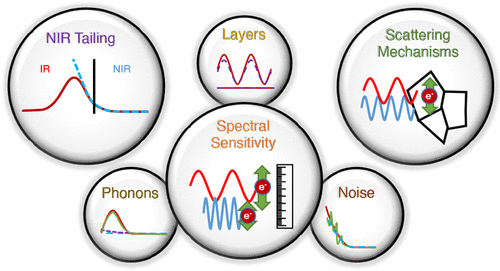当前位置:
X-MOL 学术
›
ACS Photonics
›
论文详情
Our official English website, www.x-mol.net, welcomes your
feedback! (Note: you will need to create a separate account there.)
When Ellipsometry Works Best: A Case Study With Transparent Conductive Oxides
ACS Photonics ( IF 6.5 ) Pub Date : 2020-09-25 , DOI: 10.1021/acsphotonics.0c00389 James A. Hillier 1 , Sophie Camelio 2 , Wayne Cranton 3 , Alexei V. Nabok 3 , Christopher J. Mellor 4 , Demosthenes C. Koutsogeorgis 1 , Nikolaos Kalfagiannis 1
ACS Photonics ( IF 6.5 ) Pub Date : 2020-09-25 , DOI: 10.1021/acsphotonics.0c00389 James A. Hillier 1 , Sophie Camelio 2 , Wayne Cranton 3 , Alexei V. Nabok 3 , Christopher J. Mellor 4 , Demosthenes C. Koutsogeorgis 1 , Nikolaos Kalfagiannis 1
Affiliation

|
As the library of potential materials with plasmonic behavior in the infrared (IR) grows, we must carefully assess their suitability for nanophotonic applications. This assessment relies on knowledge of the materials’ optical constants, best determined via spectroscopic ellipsometry (SE). Transparent conductive oxides are great candidates for IR plasmonics due to their low carrier concentration (compared to noble metals) and the ability to tailor their carrier concentration by manipulating the defect composition. When the carrier concentration becomes low enough, phonon and defect states become the dominant mechanisms of absorption in the IR spectral range, leading to near-IR (NIR) tailing effects. These NIR tailing effects can be misinterpreted for free carrier absorption, rendering NIR-visible-ultraviolet-SE (NIR-VIS-UV-SE) incapable of reliably extracting the carrier transport properties. In this work, we report the limitations of NIR-VIS-UV and IR-SE (in terms of carrier concentration) by investigating the transport mechanisms of indium tin oxide, aluminum-doped zinc oxide and gallium-doped zinc oxide. We find regions of carrier concentration where NIR-VIS-UV-SE cannot reliably determine the transport properties and we designate material-dependent and application-specific confidence factors for this case. For IR-SE, the story is more complex, and so we investigate the multifaceted influences on the limitations, such as phonon behavior, grain size, presence of a substrate, film thickness, and measurement noise. Finally, we demonstrate the importance of identifying the IR optical constants directly via IR-SE (rather than by extrapolation from NIR-VIS-UV-SE) by means of comparing specific figures of merits (Faraday and Joule numbers), deemed useful indicators for plasmonic performance.
中文翻译:

椭圆光度法最有效的时候:以透明导电氧化物为例
随着在红外(IR)中具有等离子行为的潜在材料库的增长,我们必须仔细评估它们在纳米光子应用中的适用性。该评估依赖于对材料的光学常数的了解,最好通过光谱椭偏法(SE)来确定。透明导电氧化物由于其低的载流子浓度(与贵金属相比)以及通过处理缺陷成分来调整其载流子浓度的能力,因此是IR等离子体的最佳选择。当载流子浓度变得足够低时,声子和缺陷态成为红外光谱范围内吸收的主要机制,从而导致近红外(NIR)拖尾效应。这些NIR拖尾效应可能会被误解为自由载流子吸收,使NIR-可见-紫外线-SE(NIR-VIS-UV-SE)无法可靠地提取载流子传输特性。在这项工作中,我们通过研究铟锡氧化物,铝掺杂的氧化锌和镓掺杂的氧化锌的传输机理,报告了NIR-VIS-UV和IR-SE(在载流子浓度方面)的局限性。我们找到了NIR-VIS-UV-SE无法可靠确定传输特性的载流子浓度区域,并为此情况指定了取决于材料和特定于应用的置信度。对于IR-SE,故事要复杂得多,因此我们研究了对局限性的多方面影响,例如声子行为,晶粒尺寸,基板的存在,膜厚度和测量噪声。最后,
更新日期:2020-10-21
中文翻译:

椭圆光度法最有效的时候:以透明导电氧化物为例
随着在红外(IR)中具有等离子行为的潜在材料库的增长,我们必须仔细评估它们在纳米光子应用中的适用性。该评估依赖于对材料的光学常数的了解,最好通过光谱椭偏法(SE)来确定。透明导电氧化物由于其低的载流子浓度(与贵金属相比)以及通过处理缺陷成分来调整其载流子浓度的能力,因此是IR等离子体的最佳选择。当载流子浓度变得足够低时,声子和缺陷态成为红外光谱范围内吸收的主要机制,从而导致近红外(NIR)拖尾效应。这些NIR拖尾效应可能会被误解为自由载流子吸收,使NIR-可见-紫外线-SE(NIR-VIS-UV-SE)无法可靠地提取载流子传输特性。在这项工作中,我们通过研究铟锡氧化物,铝掺杂的氧化锌和镓掺杂的氧化锌的传输机理,报告了NIR-VIS-UV和IR-SE(在载流子浓度方面)的局限性。我们找到了NIR-VIS-UV-SE无法可靠确定传输特性的载流子浓度区域,并为此情况指定了取决于材料和特定于应用的置信度。对于IR-SE,故事要复杂得多,因此我们研究了对局限性的多方面影响,例如声子行为,晶粒尺寸,基板的存在,膜厚度和测量噪声。最后,











































 京公网安备 11010802027423号
京公网安备 11010802027423号